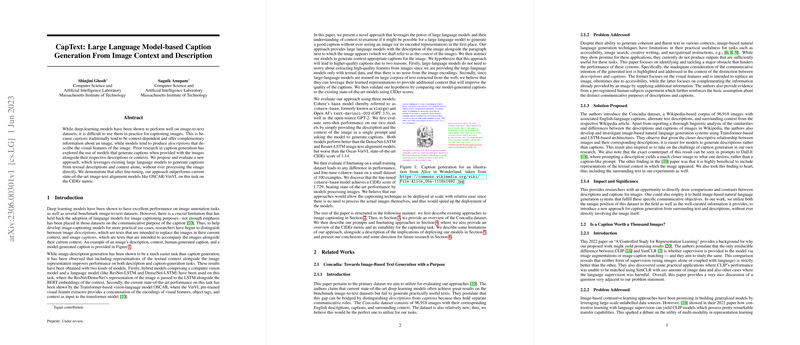CapText: LLM-based Caption Generation From Image Context and Description
The paper "CapText: LLM-based Caption Generation From Image Context and Description" presents a novel methodology aimed at improving the performance of image captioning tasks by leveraging LLMs. This approach diverges from conventional models by using textual descriptions and context, bypassing direct image processing. The paper's primary hypothesis is that LLMs can generate effective captions without image data input, a strategic choice aimed at eliminating potential noise from image encodings.
Method and Evaluation
The authors utilize the Concadia dataset, which contains images with corresponding descriptions and contexts extracted from Wikipedia articles. The dataset's utility is highlighted in the paper, emphasizing the distinct roles of image descriptions, which replace images in context, and captions, which complement visual information with additional context.
The core of the proposed approach involves feeding LLMs with image descriptions and textual context to generate context-relevant captions. Three different models were evaluated: Cohere's base model (cohere-base), OpenAI's text-davinci-003 (GPT-3.5), and the open-source GPT-2. The evaluation metric employed was CIDEr, chosen for its ability to measure semantic similarity between generated and reference captions more accurately than BLEU or ROUGE.
Initial experiments with zero-shot learning indicated that the models failed to surpass the state-of-the-art OSCAR-VinVL, which integrates visual features from a pre-trained object detection model. However, fine-tuning the cohere-base model on a small dataset significantly improved its CIDEr score to 1.73, exceeding the previous best of 1.14, thereby supporting the paper's hypothesis.
Discussion and Results
This research's approach of leveraging textual data alone without image input represents a shift in strategy for image captioning, focusing on the LLMs' inherent understanding of textual context. Despite promising numerical results, a notable limitation is the inability to verify captions' factual accuracy. An example provided in the paper illustrates this limitation, where the model generated an inaccurate caption containing incorrect historical and technical details about an Apollo mission.
Implications and Future Directions
From a practical standpoint, the methodology suggests a potential reduction in computational resources by eliminating image feature extraction, thus facilitating scalable deployment of captioning systems. The theoretical implication lies in demonstrating the potency of LLMs in tasks typically dominated by models integrating both visual and textual data.
Future research directions proposed include the integration of automated image description generation to enable entirely machine-driven caption systems. Additionally, incorporating fact-checking methods such as attribution-enhanced generation or factuality assessments could mitigate current limitations in accuracy and reliability of captions.
Overall, this paper contributes meaningfully to the discourse on image captioning by challenging the status quo of relying on dual-modality data processing, showcasing an innovative use of LLMs that could inspire further advancements and applications within the field.
